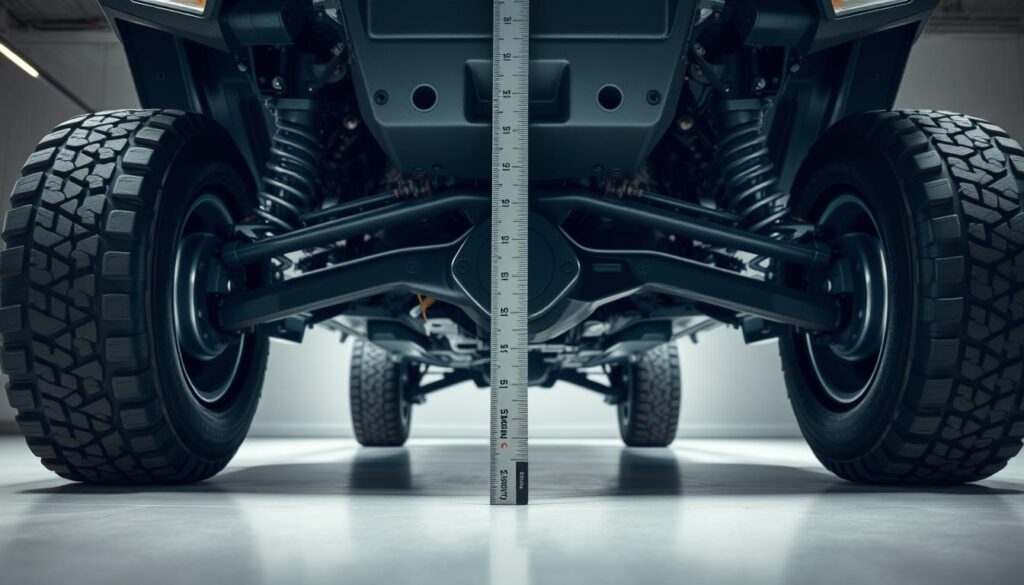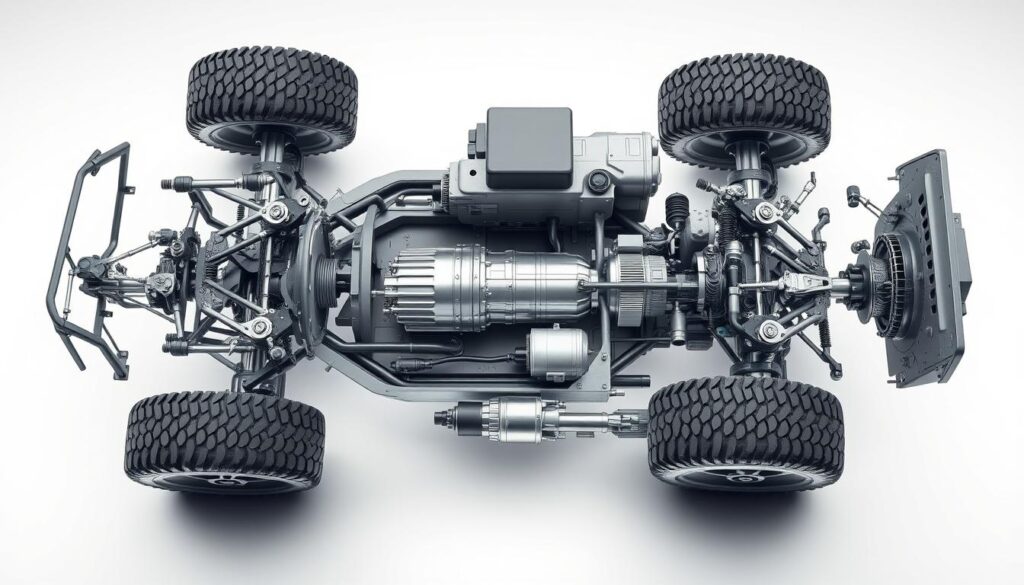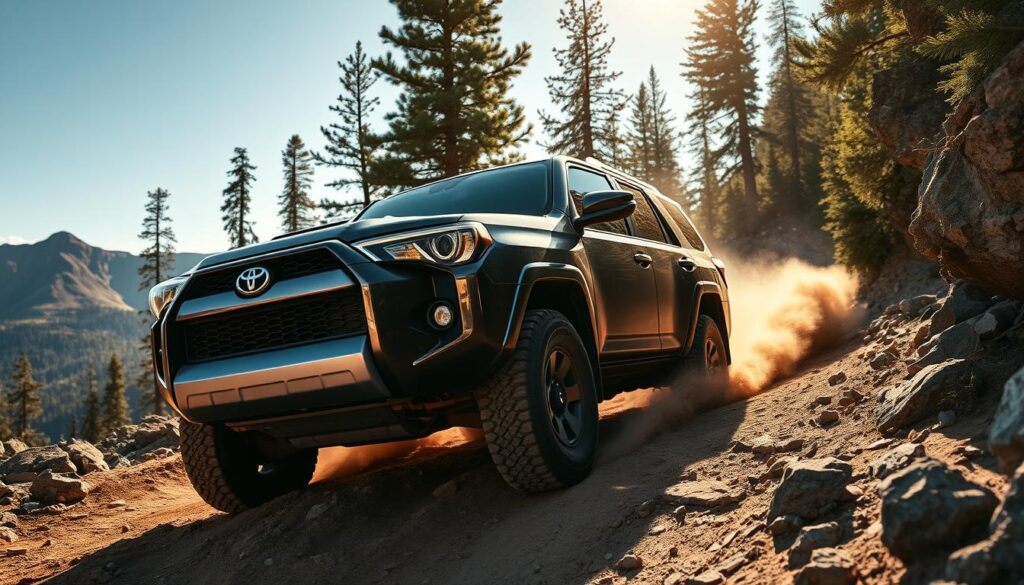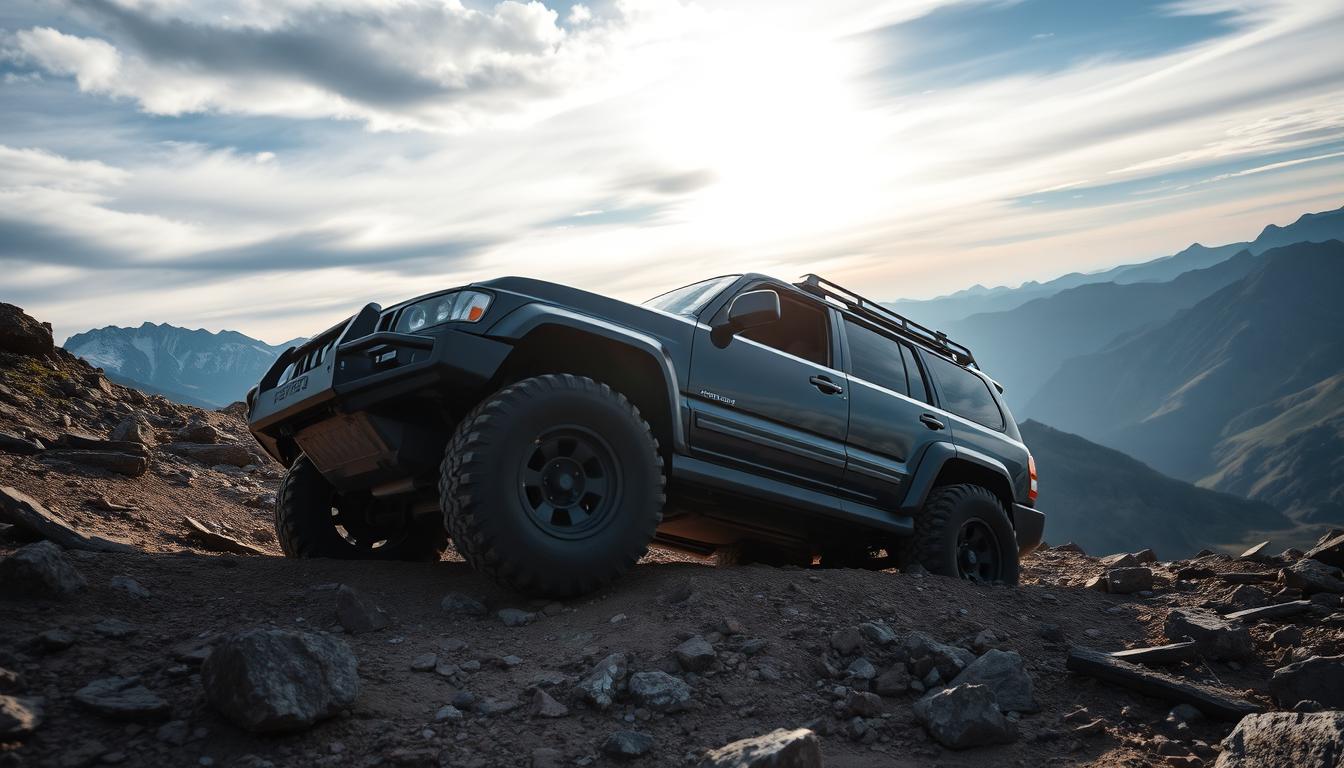Best Off-Road SUVs
Did you know that searches for rugged adventure vehicles have surged by over 300% in the past five years? More Americans than ever are trading pavement for trails, seeking outdoor experiences that demand serious vehicle capability.
Automakers have responded brilliantly, transforming family haulers into genuine adventure machines. Today’s options blend everyday practicality with impressive trail performance. They feature higher ground clearance, protective skid plates, and specialized all-terrain tires.
The evolution is remarkable. These vehicles now come with advanced terrain management systems, locking differentials, and adaptive suspensions. This technology helps conquer challenging landscapes with confidence.
Whether you prefer compact crossovers or full-size luxury models, there’s an adventure-ready vehicle for every budget. Our comprehensive guide helps you understand what makes a vehicle truly capable off-road.
We compare top models across different segments, covering both new and used markets. You’ll learn about technical specifications, brand comparisons, and practical buying advice. Modern rugged vehicles no longer sacrifice comfort or daily drivability.
Key Takeaways
- Adventure vehicle popularity has exploded, with searches increasing over 300%
- Manufacturers have transformed family vehicles into capable trail machines
- Modern systems include terrain management and adaptive suspension technology
- Options range from affordable compact models to luxury full-size vehicles
- Today’s rugged vehicles maintain comfort and daily usability
- This guide covers both new and used markets with practical buying advice
- You’ll learn to compare leading models from Ford, Toyota, Jeep, and others
Introduction to Off-Roading and SUV Innovation
The automotive landscape is witnessing a fascinating transformation as family vehicles evolve into genuine adventure companions. This shift reflects changing consumer priorities toward versatile transportation.
Overview of Off-Road Trends
Consumer preferences have moved beyond rugged aesthetics to demand actual trail capability. The surge in outdoor recreation and overlanding culture drives this change. Families now seek vehicles that handle both daily commutes and weekend explorations.
Automakers respond with specialized trim packages across their lineups. Adventure-focused editions like Trailhawk and Wilderness packages become increasingly popular. These factory-installed enhancements include increased ground clearance and protective underbody components.
Why Family SUVs Are Evolving
Family-oriented vehicles offer the perfect foundation for off-road adaptation. Their spacious interiors, comfort features, and safety systems provide ideal starting points. Manufacturers simply add trail-ready hardware to these already practical platforms.
Technological advancements make rough terrain driving more accessible than ever. Features like terrain management systems and hill descent control help newcomers gain confidence. This democratization of capability expands the potential buyer market significantly.
Premium brands now blend luxury with genuine rough-terrain performance. The result is vehicles that deliver refinement without compromising adventure readiness. This growing segment appeals to drivers seeking both comfort and capability.
Understanding Key Off-Road Capabilities

When tackling rough terrain, three technical features separate capable vehicles from pavement-only pretenders. These systems work together to conquer obstacles that would stop ordinary cars.
Ground Clearance and Tire Technology
Ground clearance measures the space between your vehicle’s lowest point and the ground. Seven inches handles light trails well. Eight to ten inches conquers moderate obstacles.
Anything over ten inches enables serious rock crawling. This measurement determines what obstacles you can drive over without damage.
Your tires provide the crucial connection to the terrain. All-terrain tires feature deeper tread patterns than highway models. They also have reinforced sidewalls for protection against sharp rocks.
Larger diameters like 31-inch or bigger tires offer better obstacle clearance. The right rubber makes a dramatic difference in traction and durability.
Locking Differentials and Traction Control
Differentials manage power distribution between wheels. Open versions send power to the wheel with least resistance. This can leave you stranded when one wheel loses grip.
Locking differentials solve this problem by forcing both wheels to turn together. This provides maximum traction when you need it most.
Modern control systems understand that some wheelspin helps in certain conditions. Off-road traction control allows controlled slipping in sand, mud, or snow. This helps maintain momentum where street systems would cut power.
| Differential Type | How It Works | Best For | Limitations |
|---|---|---|---|
| Open Differential | Sends power to wheel with least resistance | Normal road driving | Can get stuck easily off-road |
| Limited-Slip | Partially locks when slippage detected | Light trail use | May not handle extreme conditions |
| Electronic Locking | Engages lock with button or switch | Moderate to challenging terrain | Can overheat with prolonged use |
| Mechanical Locking | Full mechanical connection | Serious rock crawling | Not for pavement use |
Approach and departure angles work with ground clearance to determine obstacle capability. Angles over 20 degrees are good, while over 30 degrees excel. Skid plates protect vital components from trail damage.
Evaluating Engine Performance and Torque Delivery
The true test of an adventure vehicle’s powertrain comes during slow, technical crawling over obstacles. Low-end torque matters far more than peak horsepower in these situations.
Pulling power at low RPMs helps vehicles crawl over rocks and through mud without excessive throttle input. This controlled approach prevents wheel spin and maintains traction.
Different engine configurations serve off-road needs differently. Naturally-aspirated V6s like the Toyota 4Runner’s 4.0-liter provide 270 horsepower and 278 lb-ft torque. This combination delivers reliable trail performance.
Higher horsepower doesn’t always mean better capability. The Land Rover LR4’s 375-horsepower V-8 offers impressive numbers. Yet the Jeep Cherokee’s durable 190-horsepower six-cylinder has proven more reliable in remote areas.
Turbocharged engines provide strong low-end torque but may create lag in technical situations. This can affect precise throttle control when navigating tricky obstacles.
Adequate lb-ft torque also enables towing camping trailers or off-road toys to adventure destinations. More importantly, proven engine durability ensures you won’t face breakdowns far from assistance.
Assessing Suspension, Transmission, and Drive Systems

The foundation of any capable adventure vehicle lies in its core mechanical systems that connect power to the ground. These components determine how well a vehicle handles rough terrain while maintaining daily comfort.
Your vehicle’s suspension design fundamentally shapes its trail capability. Independent front suspension offers superior on-road comfort. Solid axles provide better articulation and durability for serious trail use.
Manual vs. Automatic Transmissions
Gearbox choice significantly impacts trail performance. Manual versions like the six-speed in the 2008 Jeep Wrangler give enthusiasts precise control. You can select exactly the right gear for technical obstacles.
Modern automatic transmissions offer sophisticated programming and convenience. They handle complex terrain situations with minimal driver input. Both options have distinct advantages for different driving styles.
| Transmission Type | Control Level | Trail Performance | Maintenance Complexity |
|---|---|---|---|
| Manual | Direct driver control | Excellent for technical crawling | Simpler to repair remotely |
| Automatic | Computer-assisted | Superior in changing conditions | More complex systems |
| Dual-Clutch | Rapid shifts | Good for high-speed trails | Specialized service required |
| CVT | Seamless power | Limited for heavy use | Unique maintenance needs |
Advanced Suspension Technologies
Modern systems automatically adapt to terrain conditions. The GMC Yukon’s four-corner Air Ride Adaptive Suspension raises the vehicle up to 2 inches when sensors detect off-road use. This provides crucial ground clearance when needed.
Ford’s Expedition Tremor features exclusive suspension tuning for optimal trail comfort. Adaptive dampers and hydraulic bump stops maintain control over rough surfaces. These technologies balance capability with daily driving refinement.
Comparing Off-Road Models from Leading Brands
Automotive brands bring unique philosophies to their trail-ready models, creating distinct choices for enthusiasts. American manufacturers like Ford and Jeep build on deep heritage with vehicles engineered for extreme terrain.
Japanese brands often emphasize reliability and longevity in their adventure vehicles. This different approach gives buyers meaningful options based on their priorities.
Performance and Practicality Balances
Pricing reveals significant differences in brand strategies. New Jeep Wranglers and Ford Broncos start well over $35,000 even in basic trims. Other manufacturers offer better value for similar capability.
Each brand balances performance with practicality differently. Some prioritize maximum trail capability above all else. Others blend ruggedness with family-friendly features like seating capacity and cargo space.
The best choice depends entirely on individual needs. Consider whether maximum capability, daily drivability, or budget matters most. Many brands offer multiple adventure-focused models at different price points.
Brand reputation for reliability and aftermarket support should influence your decision. These factors affect long-term satisfaction and future upgrade potential for your vehicle.
Ford’s Off-Road Pioneers

Ford’s Tremor sub-brand represents the company’s serious commitment to bringing genuine trail capability to its SUV lineup. This dedicated performance line brings Raptor-inspired technology to both full-size and midsize platforms.
Expedition Tremor Features
The 2025 Expedition Tremor replaces the Timberline trim as Ford’s adventure-ready model. It features Tremor-exclusive suspension tuned specifically for rough terrain comfort.
This package includes 18-inch wheels with 33-inch all-terrain tires that provide excellent grip. Heavy-duty underbody protection inspired by the F-150 Raptor shields critical components.
Trail Turn Assist technology makes tight trail navigation easier. It applies brake pressure to inside wheels to tighten the turning radius. The proven 3.5-liter EcoBoost V6 delivers strong performance.
Explorer Tremor Innovations
The 2026 Explorer Tremor brings similar capability to Ford’s midsize offering. It features Tremor-tuned suspension with increased ground clearance.
All-terrain tires on 18-inch wheels provide confident traction. Front bash plate and underbody skid protection defend against trail hazards.
Standard four-wheel drive with selectable terrain modes adapts to conditions. The reliable 2.3-liter EcoBoost engine pairs with a 10-speed automatic transmission.
| Feature | Expedition Tremor | Explorer Tremor |
|---|---|---|
| Engine | 3.5L EcoBoost V6 | 2.3L EcoBoost |
| Suspension | Tremor-tuned comfort | Increased clearance |
| Tire Size | 33-inch all-terrain | All-terrain |
| Protection | Raptor-inspired skids | Front bash plate |
| Special Feature | Trail Turn Assist | Selectable terrain modes |
Both Tremor models balance family practicality with authentic trail capability. They demonstrate Ford’s engineering focus on front rear wheel performance and durability.
Subaru’s Adventure-Ready Offerings
Subaru has carved a unique path in the adventure vehicle market with its Wilderness series. This specialized trim level builds on the brand’s legendary all-wheel-drive heritage. It adds enhanced trail equipment for serious capability.
The 2026 Trailseeker represents Subaru’s flagship adventure vehicle. Positioned above the Outback Wilderness, it features adventure-tuned suspension with higher ground clearance. Trail-ready bumpers incorporate skid plate protection and recovery points.
Trailseeker and Outback Wilderness Highlights
Subaru’s symmetrical all-wheel-drive pairs with multiple terrain modes. These optimize traction for mud, snow, and gravel surfaces. The system provides confidence across challenging landscapes.
The 2026 Outback Wilderness features a revised CVT transmission. It’s specifically tuned for better low-end torque delivery. This helps during technical crawling and obstacle navigation.
| Feature | Trailseeker | Outback Wilderness |
|---|---|---|
| Engine | 2.4L Turbo (260 hp) | 2.4L Turbo (260 hp) |
| Suspension | Adventure-tuned | Revised for trails |
| Tire Type | All-terrain tires | Upgraded all-terrain |
| Special Features | Recovery points | Hex LED fog lights |
The 2026 Subaru Forester Wilderness offers impressive 9.3-inch ground clearance. It comes standard with X-MODE traction control. Practical interior features include water-repellent StarTex upholstery.
This material handles muddy gear and wet conditions perfectly. It’s ideal for active families who enjoy outdoor adventures. The trim balances rugged capability with everyday practicality.
Toyota’s Trailblazing Off-Road Warriors

For decades, Toyota has been synonymous with rugged reliability in the world of trail-capable vehicles. Their reputation for building bulletproof machines spans generations of adventurers.
The brand’s commitment to durability makes their vehicles excellent long-term investments. Many models regularly exceed 200,000 miles on original powertrains.
4Runner and FJ Cruiser Capabilities
The Toyota 4Runner stands as one of the brand’s flagship adventure models. Its body-on-frame construction provides exceptional structural integrity.
The 2010 4Runner’s 4.0-liter V-6 delivers 270 horsepower and 278 lb-ft torque. This proven powertrain combines strong performance with legendary reliability.
The FJ Cruiser offers a unique retro-styled approach to serious trail capability. It shares the same durable 4.0-liter V-6 engine, producing 239 horsepower.
Available locking rear differentials provide maximum traction when needed. Enthusiasts appreciate the six-speed manual transmission option for precise control.
| Feature | Toyota 4Runner | FJ Cruiser |
|---|---|---|
| Engine | 4.0L V-6 | 4.0L V-6 |
| Horsepower | 270 hp | 239 hp |
| Torque | 278 lb-ft | N/A |
| Transmission | Automatic | 6-speed Manual Available |
| Key Feature | Body-on-Frame | Locking Rear Differential |
Body-on-frame construction isolates rough-terrain punishment to the steel frame. This protects the vehicle body and ensures decades of reliable service.
While newer models offer advanced technology, used Toyota vehicles represent outstanding value. Their legendary durability and strong resale values make them smart choices.
Luxury and Performance in Off-Road SUVs
The boundary between luxury refinement and rugged trail capability continues to blur dramatically. Premium manufacturers now deliver vehicles that excel in both environments.
Lexus and Volvo’s Off-Road Innovations
The 2024 Lexus GX 550 Overtrail represents the pinnacle of this convergence. Its new 349-horsepower twin-turbo V6 generates 479 lb-ft of torque.
This advanced model features a standard electronic locking rear differential. This system ensures maximum traction when navigating challenging terrain.
Lexus has built its reputation on reliability. The 2007 GX 470 earned an impressive 85/100 JD Power reliability score.
Volvo’s EX30 Cross Country brings electric innovation to the segment. Its 422-horsepower Twin Motor Performance powertrain delivers instant torque.
The 2011 Land Rover LR4 showcases impressive capability with its 375-horsepower V-8. However, its 75/100 reliability score requires consideration.
These luxury vehicles prove premium comfort and genuine trail performance are no longer mutually exclusive. They maintain sophisticated interiors while conquering rough landscapes.
Advanced Off-Road Systems and Technologies
Modern adventure vehicles rely on sophisticated drive technologies that transform challenging terrain into manageable pathways. These advanced systems work together to provide confidence and capability when you need it most.
The fundamental difference between all-wheel drive and four-wheel drive comes down to operation. AWD systems typically work automatically, while 4WD requires driver selection for optimal performance.
All-Wheel and Four-Wheel Drive Systems
Today’s all-wheel drive systems use electronic controls to constantly monitor wheel slip. They redirect torque to wheels with the best traction, providing excellent performance in varied conditions.
Traditional four-wheel drive systems feature two-speed transfer cases. High-range handles slippery roads, while low-range multiplies torque for serious crawling.
Having a three-speed transfer case in your 4WD system offers even greater flexibility. This setup provides additional gearing options for different trail challenges.
Innovative Terrain Modes and Driver Aids
Innovative terrain mode systems allow drivers to select preset configurations for specific conditions. These modes automatically adjust throttle response, transmission shift points, and traction control.
Electronic Brake-Lock Differentials, like those in the 2014 Nissan XTerra, simulate locking differentials effectively. They apply brakes to slipping wheels, forcing power to wheels with solid grip.
Advanced driver aids include hill descent control that maintains steady speed downhill. Hill start assist prevents rollback when starting on inclines, adding security.
Modern off-road systems integrate multiple technologies into unified packages. Terrain modes, locking differentials, and suspension adjustments work together through intuitive interfaces.
Evaluating Used Off-Road SUVs for Budget Buyers
Smart shoppers know the real value often lies in the used vehicle market. New adventure machines often start above $35,000 for basic trims. This makes pre-owned vehicles an attractive alternative for budget-conscious buyers.
The used market offers a wide range of price points and options. Proven models like the 2010 Toyota 4Runner hold their value well, averaging around $16,640. This reflects their legendary reliability and lasting capability.
You’ll find impressive value across different price categories. The 2012 Subaru Forester provides standard all-wheel drive for approximately $5,197. Even luxury models become accessible, with the 2008 Porsche Cayenne averaging just $5,743.
| Vehicle Model | Year | Average Price | Key Feature |
|---|---|---|---|
| Toyota 4Runner | 2010 | $16,640 | Legendary reliability |
| Jeep Wrangler | 2008 | $10,097 | Four-door versatility |
| Lexus GX 470 | 2007 | $9,977 | Premium luxury features |
| Subaru Forester | 2012 | $5,197 | Standard all-wheel drive |
| Jeep Cherokee | 2000 | $3,892 | Budget champion |
Careful evaluation is crucial when considering any used vehicle. Check maintenance records and ask about previous off-road use. Look for signs of wear on critical components like suspension and drivetrain.
Remember that the purchase price is just the beginning. Budget for potential repairs and upgrades since trail driving demands much from any vehicle. This approach ensures your adventure starts on solid footing.
Best Off-Road SUVs
From rock-crawling specialists to luxury explorers, manufacturers now deliver diverse trail-ready options. These models combine rugged hardware with smart technology for confident exploration.
The Jeep Wrangler Rubicon stands as the benchmark for serious trail performance. Its factory equipment rivals custom builds, making it exceptionally capable off-road. The Ford Bronco Wildtrak challenges this dominance with modern technology and refined road manners.
For those prioritizing reliability, the Toyota 4Runner TRD Pro delivers proven off-road capability with legendary durability. Versatile options like the Nissan Xterra PRO-4X and Chevy Tahoe Z71 balance trail performance with family practicality.
Luxury seekers have impressive choices that refuse to compromise comfort. The Mercedes-Benz G-Class and Lexus GX/LX Series offer premium amenities without sacrificing trail readiness. Land Rover Defender continues its legacy of sophisticated exploration.
Emerging options like Subaru’s Wilderness suvs bring adventure readiness to efficient platforms. The Outback, Forester, and Crosstrek models provide accessible capable off-road performance for various budgets.
Each vehicle category serves different adventure styles and requirements. Whether tackling extreme trails or family camping trips, there’s a model with the right off-road capability for your needs.
Key Buying Tips for Families and Adventurers
The most successful vehicle purchases happen when you match technical specifications with your specific lifestyle requirements. This approach ensures your investment serves both adventure dreams and daily realities.
Essential Features and Practical Amenities
Prioritize vehicles with at least 8 inches of ground clearance and proven four-wheel-drive systems. All-terrain tires and protective skid plates are non-negotiable for serious trail use.
Consider your family‘s needs regarding seating capacity and cargo space. Roof racks with high weight ratings accommodate rooftop tents and adventure gear. Look for integrated air compressors and recovery point mounting locations.
Always carry essential equipment like portable air compressors. Reduce tire pressure by 25% for rough terrain, then reinflate for pavement driving. Traction boards provide vital recovery assistance when wheels lose grip.
Aftermarket Support and Upgrade Options
Research available trims and their upgrade potential before purchasing. Popular platforms like Jeep Wranglers offer extensive aftermarket options.
Some vehicles accommodate upgrades more easily than others. Nissan XTerra owners successfully fit 33-inch all-terrain tires without lift kits. This flexibility adds value to your purchase.
Never venture out alone and always research trail conditions beforehand. Cell service is unreliable in remote areas, so proper preparation ensures safe adventures for your entire family.
Off-Road Maintenance, Safety, and Upgrades
Trail adventures demand more than just capable vehicles – they require smart preparation and regular upkeep. Rough terrain places extraordinary stress on every component.
Maintenance intervals should be more frequent than highway driving. Change oil, differential fluid, and transmission fluid regularly. Inspect the underbody for damage after each outing.
Your tires need special attention. Rotate them often and check pressure before hitting the trails. Look for cuts in the sidewalls and know when to replace worn tires.
Always carry essential safety gear. This includes traction boards, recovery straps, and a first aid kit. Bring several days’ worth of food and water for emergencies.
Choose reliable platforms like Toyota 4Runners with proven powertrain durability. The Jeep Cherokee’s 4.0-liter engine is legendary for its toughness. Research trail conditions and never venture out alone.
Respect the environment by staying on designated paths. Pack out all trash and be considerate of wildlife. Proper preparation ensures safe, enjoyable adventures for everyone.
Future Trends in the Off-Road SUV Market
Silent operation and instant torque delivery are transforming the off-road experience as electric models enter the market. The 2026 Subaru Trailseeker demonstrates this shift with its all-electric platform.
Emerging Technologies and Sustainability
Electric suvs like the Volvo EX30 Cross Country showcase impressive performance. Its 422-horsepower Twin Motor powertrain achieves 0-60 mph in 3.4 seconds.
Electric powertrains offer significant advantages for trail use. Instant torque at zero RPM provides immediate obstacle response. Precise throttle control enhances technical crawling capabilities.
The traditional internal combustion engine faces competition from advanced electric systems. Modern transmission designs adapt to handle electric motor characteristics.
Range anxiety remains a concern for electric adventure suvs. However, rapid charging capabilities continue improving accessibility.
Hybrid technologies combine traditional engine reliability with electric efficiency. These systems maintain off-road capability while extending range from their base configuration.
Advanced suspension systems use predictive camera technology. They adjust settings before encountering obstacles for optimal performance.
Conclusion
The journey toward finding your perfect adventure vehicle begins with understanding how far these versatile machines have evolved. Today’s market offers impressive choices across every price point and vehicle size, from compact crossovers to full-size luxury models.
Modern suvs successfully balance genuine trail readiness with family-friendly practicality. They deliver comfort and technology for daily driving while maintaining serious off-road capability when adventure calls.
Remember the essential features that make a vehicle truly capable off-road: proper ground clearance, locking differentials, and quality all-terrain tires. Whether you choose cutting-edge new models or proven used vehicles, these fundamentals matter most.
Brands across the spectrum now offer dedicated adventure trims, making trail capability more accessible than ever. Carefully assess your specific needs regarding family requirements, budget, and desired performance level.
Your next step? Visit dealerships for test drives, research specific models, and connect with the off-road community. The perfect vehicle for your adventures on and off the trails awaits discovery.
FAQ
What is the difference between all-wheel drive and four-wheel drive?
Why is ground clearance so important for an off-road vehicle?
What do locking differentials do, and do I need them?
Are all-terrain tires sufficient for off-road driving?
How does torque affect an SUV’s off-road performance?
What are terrain management systems?
Is a manual transmission better for off-roading?
Can a family SUV like a Subaru Forester or Toyota 4Runner be a good off-road vehicle?

Sharon Molly is a content creator in lifestyle, fashion, and travel, delivering style-savvy advice and destination insights to inspire confident living. With a background in digital media, she combines aesthetics with practical guidance for modern women on the go.




